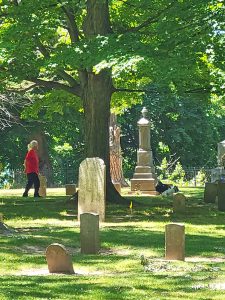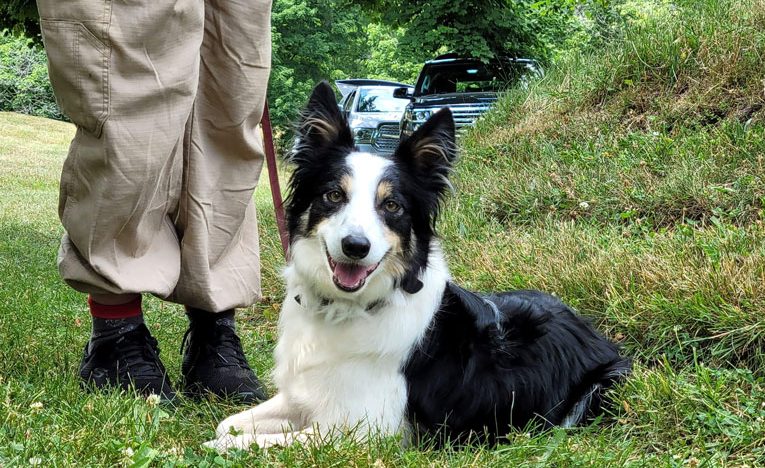BELWOOD – On this day, Quincee, a four-year-old border collie, was annoyed by flies, was curious about a delivery and made it clear she’d like a tummy rub from a visitor.
But not long ago, Quincee was in a forested site, sniffing the ground, helping investigators discover where a human body had been discarded 55 years ago.
And she’s going back in a couple of weeks to search some more.
Quincee is a certified human remains detector dog – HRD for short. Cadaver dog is perhaps the better-known term, although her owner Les Huber prefers the former.
Huber is a retired veterinarian who lives in Belwood and Quincee was a year-and-a-half when Huber signed her up for training at the Centre for Forensic Training and Education in Ohio.
“A friend said, are you interested in trying this? I thought it would be interesting,” Huber said.
In 2020 she and Sherry Hall and her dog Talon formed Ontario Search and Recovery Canines, a group of certified HRD dogs and their owners, who can help with cold cases and archeological studies.
The training for certification is intense.
The dogs are trained to detect the odour of decomposition. It’s difficult to get material, but when they do it is buried in a controlled site and the dog left to find it.
“The odour never really disappears,” she said. “Organic chemicals gas off and the dogs are trained to find this odour.
“Cold cases take a lot of training. Live people have a scent; dead people have odour.”
When the dogs detect the smell, they give their signal – Quincee will drop to the ground but other dogs might sit or bark.
In an actual investigation, the site would be marked and the human investigator called in.
The dogs also train in cemeteries and “I have to laugh,” Huber said. “They go everywhere because there’s odour everywhere.”
But Quincee likes to be working and while it might seem like gruesome work, she’s working for her reward: a toy.
The reward for Huber is that she and Quincee are using their unique skills to help people.
“I lost a son at 19-days-old. He died at Sick Kids. I know what happened and I know where he is buried,” she said.
“But when your child is taken like this, you don’t know. There’s no closure. Grief needs closure.”
Working on a cold case
Quincee and Huber work for MUCCI – Missing, Unidentified, Cold Case Investigations – a volunteer organization made up of retired police officers, archeologists, writers and researchers, and HRD dogs that follow up on cold cases.
Quincee and the rest of the investigative team are on the case of Marianne Schuett, the 10-year-old girl from Kilbride, north of Burlington, who went to school one day in April 1967 and never returned home.
At the time, she was seen getting into a station wagon with a 40-year-old man. A vehicle of similar description was seen in the area of Rattlesnake Point.
A blue running shoe, believed to be Marianne’s, was found in Speyside, a small community on Highway 25 north of Milton, a few days after Marianne went missing.
And although hundreds of people came forward to help with the search – the biggest land search in Canada at the time – Marianne’s killer was never charged. And Marianne’s body was never recovered.
Linda Gillis Davidson is a retired RCMP officer and Gord Collins a retired Peel Police officer and forensics specialist. They took their combined skills and passion for solving cold cases and formed MUCCI.
Collins said when the Marianne Schuett case came to them, he was all over it.
He grew up near Kilbride and remembers the case when it happened. And since re-opening this cold case, he’s come to know Marianne’s brothers, David and Steven, who have also taken part in more recent searches for Marianne.
Halton Police believe Marianne’s killer is responsible for a string of sexual assaults and abductions.
He was jailed in 1972 for the attempted abduction of a 17-year-old girl in Burlington and is believed to be responsible for the sexual assaults of two girls in Ancaster between 1971 and 1978.
The man died by suicide after he was confronted with these assaults and Marianne’s disappearance.
So it won’t be evidence of the crime that Collins is hoping to discover. Nor does he expect to find a body after 55 years.
“The goal is to give her family an answer as to where Marianne was left,” he said.
“We don’t have great expectations of finding major remains. But if we could get a DNA sample, that would be sufficient for the family.”
The team opened the case in 2019 and brought the HRD dogs to a site in Speyside in September 2020. The dogs identified an area and the archeologist began the painstaking work of sifting through the soil looking for clues.
They managed to find a piece of fabric and took it to a lab in Guelph for testing. The lab confirmed that the fabric contained human DNA but the sample was too degraded to confirm it was Marianne’s.
They are heading back in a couple of weeks to continue the search.
“We know a body was dumped there,” said Gillis Davidson. “Four dogs were on the site and all four, independently, marked the same identical place. So we know somebody died here because decomposition has taken place.”
Gillis Davidson said back in the day, there was a field where people left their old cars. She believes the killer took Marianne there, dumped her body, and covered her with rocks.
When they go back, Gillis Davidson said they will dismantle the rock wall and see what they see.
“Something could exist. We may find a piece of bone,” she said.
Collins said he believes Marianne’s killer is responsible for other missing persons and said they may turn up DNA at this site that gives closure to other families.
“The dogs are very helpful,” he said. “They narrow the scope considerably.”
Uncovering history
Solving cold cases can be thrilling, but Huber prefers the other work HRD dogs can do – uncovering history.

Quincee and her handler Les Huber work in a cemetery at Old Fort Niagara. Photo by Dari Sharp
She comes from the Niagara region and Laura Secord is part of her ancestry. So she loves helping historical societies, municipal governments and individuals identify historical burial grounds.
“A lot of cemeteries started as family plots and then expanded,” she said, adding the record-keeping 100 and 200 years ago was not that good.
She said some bodies were buried and the headstones installed years later.
“Often they were buried without headstones, or headstones were placed where they think the body was buried,” Huber added.
HRD dogs will sniff between the graves as well as at the graves to identify these unmarked graves.
Paul Martin, owner of Martin Archaeology Consulting based in Tenessee, uses HRD dogs in his work. He also runs a training school, where Huber and Quincee have attended.
He too is involved in cold cases and police work, but a project he’s very proud of is History Flight – a project to locate and recover the remains of missing U.S. service members.
“We’re searching for these soldiers who were killed in the Second World War,” he said.
“With technology, we’re able to take information about where planes crashed, and have been able to locate and recover them 70 years after they were killed in action.
“We have also found the graves of enslaved people, and that’s 160 to 200 years ago.”
He added, “With dogs and ground penetrating radar, we get a better understanding about what’s under our feet. It’s an amazing way to interact with history.”
Back in Belwood, Huber said her group OSARC is willing to take on cases.
The dogs are properly trained and certified to do the work and that lends credibility to their findings.
“We’re hooked on these burial sites. If I could find Richard Pierpoint’s grave, I’d die happy,” she said.
For more information email leshuber100@gmail.com.




